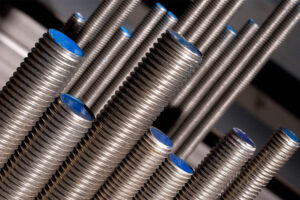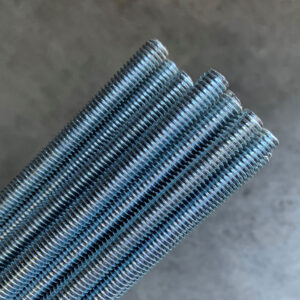A threaded rod, also known as a screw or stud, is a cylinder with helical grooves cut into its outer surface or a cone with helical grooves cut into a conical surface, and has threads along its entire length. The screws have different heads, such as outer hexagonal screws, large flat screws, inner hexagonal screws, etc.
A screw is a common mechanical component, a slender helical metal structure used to transmit kinetic energy and drive mechanical motion.
Material selection for threaded rods
Screws and screw rods work under high temperature, certain corrosion, strong wear and high torque. Therefore, the following conditions must be met:
1. High temperature resistance, no deformation under high temperature;
- Wear resistance, long life;
- Corrosion resistance, the material is corrosive;
- High strength, can withstand high torque, high speed;
- Good cutting performance;
- After heat treatment, the residual stress is small, and the thermal deformation is small.
Common Threaded Rod Materials
Stainless Steel: Stainless steel grades commonly used for threaded rods include 304, 316, and 17-4ph. Stainless steel threaded rods are suitable for applications requiring resistance to corrosion, heat and chemicals.
Steel: Steel threaded rods are the most commonly used type and are known for their strength, durability, and cost-effectiveness. Threaded rods can be made of low carbon steel, medium carbon steel or high carbon alloys and can be coated with zinc, black oxide or other corrosion resistant coatings.
Brass: Brass threaded rods are corrosion resistant and conduct electricity well. They are commonly used in applications such as fasteners, plumbing and electrical components.
Aluminum: Aluminum threaded rods are lightweight, corrosion resistant, and electrically conductive. They are commonly used in construction, electronics and automotive applications.
Factors Affecting the Strength of Threaded Rods
- Tensile strength: The maximum bearing capacity of the threaded rod under static tensile conditions. (GB/T 228-1987 old national standard stipulates that the symbol of tensile strength is σb), and the unit is MPa. The tensile strength of threaded rods is affected by factors such as material, diameter and rod length.
- Shear strength: The maximum load that a threaded rod can withstand before it is sheared or broken at a perpendicular angle to its length, also known as the ultimate strength when the material is sheared. It is generally lower than the tensile strength, and the shear strength of threaded rods is affected by factors such as thread type and fastening material.
- Yield strength: The yield limit of the threaded rod when yielding occurs, that is, the stress against micro plastic deformation. Yield strength is also generally lower than tensile strength, and the yield strength of threaded rods is affected by factors such as material and temperature.
- Fatigue strength: The maximum stress that the threaded rod will not produce damage under the action of infinitely many alternating loads. Fatigue strength can be affected by factors such as material properties, surface finish, size, chemical composition and threaded rod design.
Type of threaded rod
- Fully threaded screw: It is generally composed of two parts: a screw and a nut. The threaded rod has threads along its entire length. Its working principle is to achieve fastening and loosening through the rotation of the thread. It is widely used to realize the connection function during the disassembly, maintenance and assembly of mechanical equipment.
- Double-ended threaded rod: refers to a fully threaded rod with threads at both ends, which is often used to connect two mechanical parts.
- Partially threaded rod: refers to a threaded rod whose length is partly threaded and needs to be assembled or disassembled by a threaded nut, and the other part needs to be fixed on other surfaces.
- ACME threaded rod: refers to the threaded rod with ACME thread, the ACME thread standard is a commonly used international standard thread for applications that carry heavy loads or require large clamping forces.
- Threaded Studs: These are shorter threaded rods that are often used to fasten components directly to surfaces. They are threaded on one or both ends and unthreaded on the other.
- Fully threaded bolt: It is a fastener used to connect and fix parts. It has the characteristics of full thread, same thread length and high strength. It is often used in ships, railways, construction, machinery and other fields. In addition, it also has the advantages of strong anti-loosening ability and convenient use.
Types and applications of screw rods
According to its thread shape, the screw can be divided into triangular screw, trapezoidal screw and round screw. Among them, the trapezoidal thread screw is the most commonly used, and its pitch is small, so it can withstand a large load.
Screw rod is a commonly used part in mechanical transmission, mainly used to convert rotary motion into linear motion or force into torque. Widely used in machine tools, stage lighting equipment, car lifting systems, etc.
Features of the screw
- The manufacturing process of high-precision screw rod is very fine, which can realize high-precision motion control.
- High-efficiency screw has high efficiency and can convert most of the kinetic energy into linear motion or torque.
- Easy to maintain The structure of the screw rod is relatively simple, easy to maintain and replace.
- High reliability The material of the screw rod is generally high-strength steel or titanium alloy, which has good wear resistance and corrosion resistance, and can run stably for a long time.
The difference between screw and screw
The screw and the screw are very similar, but the screw and the screw are different in exact terms. The screw is a kind of screw, and the screw generally refers to a relatively small pitch. Generally speaking, the lead of the screw Or the pitch is bigger.
- Structure: The structure of the screw and the screw is similar, both are composed of threads and axis lines, but their shapes are different. Screws have a variety of different cross-sectional shapes, common ones are round rods, hexagonal rods, etc., while most screw rods have circular cross-sections, and the angle of their threads is usually 60 degrees.
- Material: Screws are generally made of high-quality alloy steel, which can maintain stability under large loads and high-speed transportation; screw rods are generally made of carbon steel, which usually work under lower loads and low speeds, so the strength requirements are not high .
- Use: Because the strength and bearing capacity of the screw are stronger, it is usually used in mechanical equipment that needs to be adjusted frequently or bear heavy loads, such as car lifts, injection molding machines, excavators, etc.; the screw is usually used for low speed Servo motors, linear motion controllers, robot joints, etc.
- Difficulty in manufacturing: Due to the many cross-sectional shapes of the screw, the processing difficulty and process requirements are relatively high, and complex processes such as cutting, forging, and heat treatment are required; while the processing of the screw is relatively simple, ordinary lathes, cutting , Grinding and other processes.
- Maintenance and maintenance: The accuracy and load capacity requirements of the screw are higher than that of the screw, and it needs to be more careful and cautious in maintenance and maintenance, and regular use of lubricating oil for maintenance and protection; while the maintenance requirements of the screw are relatively slightly lower , just add an appropriate amount of lubricant according to the cut-off port.

 English
English Deutsch
Deutsch Français
Français 日本語
日本語

